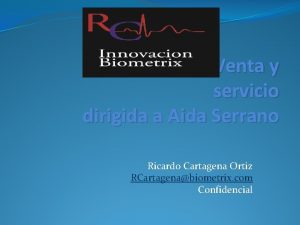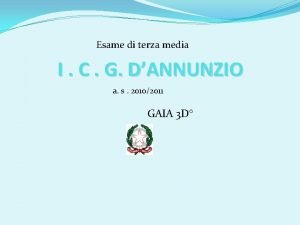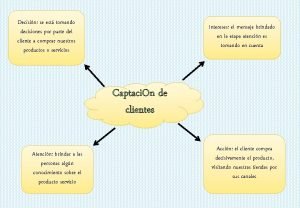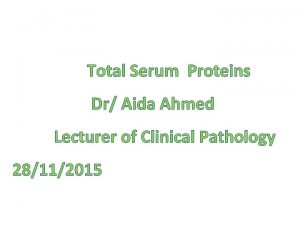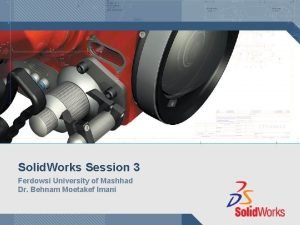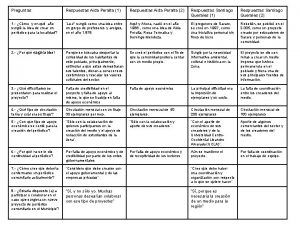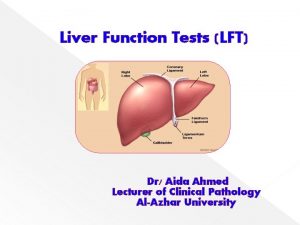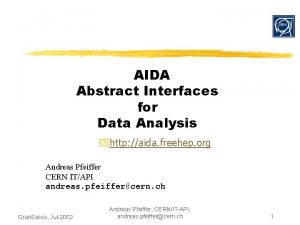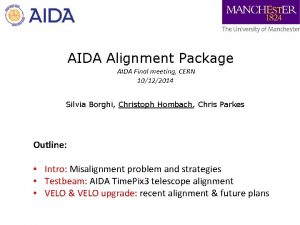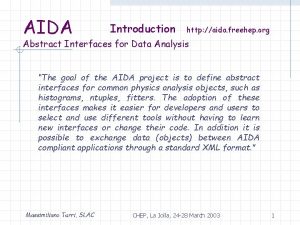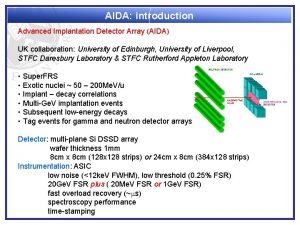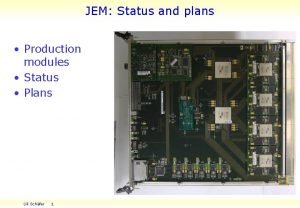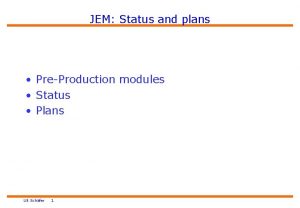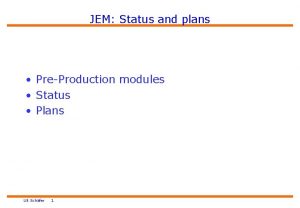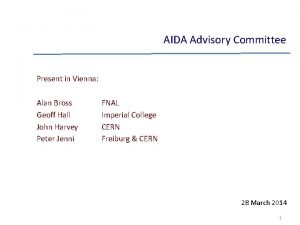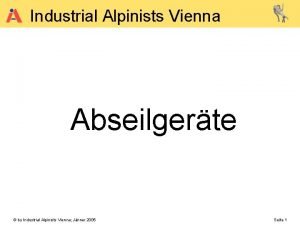AIDA WP 9 4 Status and Plans Vienna


















- Slides: 18

AIDA WP 9. 4: Status and Plans Vienna Marko Dragicevic (HEPHY Vienna) AIDA 1 st Annual Meeting 29 March 2012

Outline • Sensors and detectors modules – News on existing (Si. LC) and new sensors – Options for modules with existing sensors – Design options for new sensors • Progress on DAQ software and analysis framework • Summary and discussion (with proposals) 29 March 2012 Marko Dragicevic (HEPHY Vienna) 2

Reminder: Sensor Procurement Options • Try to get the existing HPK sensors already procured by the Si. LC collaboration years ago – Discovered modules with the sensors in Paris • Design and produce new sensors with – On. Semi – 2 D Resistive Sensors from IFCA Santander/CNM Barcelona (not covered here) 29 March 2012 Marko Dragicevic (HEPHY Vienna) 3

Reminder: Answers from CALICE We contacted CALICE (Felix Sefkow) • What should be the area to cover with silicon? 10 x 10 cm is rather easy, but anything more makes the project much more expensive. We think that 10 x 10 cm 2 is just sufficient, a bit more (12 x 12 or 15 x 15) would give us some safety margin. • How precise should the entry points in the calorimeter be defined, or, in other words, what is the (realistic) resolution you require for that? A sub-millimeter accuracy would be by far sufficient. For most studies drift chambers would do, actually. However, for detailed uniformity checks more precision would be desirable, and 0. 1 mm would cover it all. 29 March 2012 Marko Dragicevic (HEPHY Vienna) 4

Sensor Procurement: Si. LC Sensors Remember: • Large area sensor: 95 x 95 mm 2 • Very fine pitch: 50 µm • Lots of channels: 14 x 128 = 1792 Plans for the rediscovered sensors • Carefully recuperate sensors from module • Testing (IV, CV and strip characterisation) Caveats for usage • Large number of strips and small pitch but requirements for resolution are much lower (≥ 100 µm) • We might skip 2 -3 strips (pseudo-intermediate-strips) Example: – – • 3 intermediate strips 1792 /4 = 448 channels = 3. 5 APV 25 pitch = 200 µm digital resolution 200/sqrt(12) ≈ 60 µm Pitch adapters from APV 25 to sensor 29 March 2012 Marko Dragicevic (HEPHY Vienna) 5

Sensor Development with On. Semi • 4” and 6” production possible – Clearly want to go for 6” to get large sensors • 1 Idea to use stepper instead of full masks 6 2 – Cheaper – Not clear if feasible • • • Alignment of steps with limited precission Might introduce sharp corners Prone to introduce local breakdown/microdischarge – Limits the number of structures on wafer – Design gets much more complicated Prefer to go with full masks! • Radiation Hardness? 7 9 5 – Radiation hardness is not an issue of this project – Interesting for studies in LHC experiments – Would not hurt to use rad-hard material • Suggestion: – High resistivity, high O concentration FZ – 200 µm thickness – n-on-p process with p-stop strip isolation 3 29 March 2012 Marko Dragicevic (HEPHY Vienna) 8 4 6

Stitching strips together 29 March 2012 Marko Dragicevic (HEPHY Vienna) 7

Wafer Layout General Strategy • Large main sensor – Use full area for 10 x 10 cm 2 main sensor? – Reduce size to have space for small test sensors • Small test sensors – For studies on various sensor design choices • Test structures – Fill available space with standard and new test structures 29 March 2012 Wafer layout made by HEPHY as example Marko Dragicevic (HEPHY Vienna) 8

Main Sensor • Size – Maximum area: 10 x 10 cm 2 – Full length, reduced number of strips (as in example) 10 x 6 cm 2 – Reduced size but square shaped 8 x 8 cm 2 • 2 D resolution: stereo solutions – Include stereo angle on sensor (inclined strips) – Identical square shaped sensors rotated on module – Use 90 stereo angle and use 2 nd metal layer for routing of the strips • Pitch/Resolution – Very relaxed requirements from CALICE (100 µm resolution as best option) – Would prefer reasonably small pitch eg. 100 µm usefulness of sensors for other applications – Limit number of readout channels using pseudointermediate-strips and get effective readout pitch of eg. 200 µm 29 March 2012 Marko Dragicevic (HEPHY Vienna) 9

Test Structures: Standard Halfmoon • Seven structures to measure specific parameters • Allows assessment of the quality of the production process • Has been an important tool in the CMS production • Helps in identifying problems in the production and suggest improvements • Vienna has extensive experience with such structures (design/measurement/interpreta tion) 29 March 2012 Marko Dragicevic (HEPHY Vienna) 10

More Test Structures: Van der Pauw • Measure resistivity of implants • Tiny structures • Can be distributed around wafer to evaluate homogeneity of the production process • We are evaluating different designs and want to optimise the layout 29 March 2012 Marko Dragicevic (HEPHY Vienna) 11

More Test Structures: SIMS Fields • Provides windows to naked silicon with different dopings • Can be used to measure doping concentrations and resistivity – SIMS – SRP 29 March 2012 Marko Dragicevic (HEPHY Vienna) 12

Temperature Monitoring • Measure temperature with resistive structure on sensor periphery • Need to investigate thermal coefficients and resulting signals depending on material – Aluminium – Polysilicon with different doping concentrations • Design test structures to evaluate different geometries • Integrate promising versions into sensor periphery Idea presented by Alberto Messineo for the CMS Tracker 29 March 2012 Marko Dragicevic (HEPHY Vienna) 13

Readout System and Software: APVDAQ • Two related APV 25 readout systems were designed/built at HEPHY – APVDAQ: small system for laboratory tests – Belle II readout prototype: medium sized system • New large scale Belle II system will be built – This would leave us with more availability of the medium sized system • Online DAQ software and offline analysis tools were not user friendly and based on proprietary framework (Lab. Windows/CVI) • We want to rewrite software from scratch – Common, portable and free software frameworks: C++, ROOT, Qt GUI, etc… – Target Platform: Linux 29 March 2012 Marko Dragicevic (HEPHY Vienna) 14

Online DAQ: Tux. DAQ Online DAQ software • Now implemented for the medium scale Belle II readout system • Production version will be ready for testbeams in summer/autumn 2012 • Still needs implementation of online analysis to monitor data quality – Will be ported from HAT see next slide • Slight modifications needed to operate also the small APVDAQ system 29 March 2012 Marko Dragicevic (HEPHY Vienna) 15

Offline Analysis Framework: HAT: HEPHY Analysis Tool • Flexible framework to analyse data from our HEPHY readout systems • Modular OO code allows integration of data structures from other DAQ systems and the implementation of custom analysis steps • Full analysis chain is now available and under extensive tests 29 March 2012 Marko Dragicevic (HEPHY Vienna) 16

Summary and Discussion • Online DAQ and offline analysis tool is progressing well • Si. LC sensors modules have finally been discovered – Need to recuperate sensors and test them • Discussion: existing Si. LC sensors vs. design and produce new sensors – Proposal: • Make use of Si. LC sensors (assuming that they are still OK) • In parallel develop a new wafer layout and produce sensors with On. Semi • Discussion: Si. LC sensor to module strategy – Proposal: • Use 3 pseudo-intermediate-strips • Use stereo angle of 90° • Readout from two sides 29 March 2012 Marko Dragicevic (HEPHY Vienna) 17

Summary and Discussion • New sensor production – Still need to clarify plenty of details with On. Semi and CNM Barcelona • Discussion: Design choices for a new sensor – Proposal • • • 29 March 2012 Go for a smaller but square shaped main sensor 8 x 8 cm 2 Readout pitch of 100 µm Use single pseudo-intermediate strip 200 µm pitch Use stereo angle of 90° Readout from two sides Tile 2 or 4 modules to cover larger area Marko Dragicevic (HEPHY Vienna) 18
 Congress of vienna map before and after
Congress of vienna map before and after Aida persuasive message
Aida persuasive message Aida serrano
Aida serrano Itme stratejisi
Itme stratejisi Aida shafira
Aida shafira Marcia trionfale flauto
Marcia trionfale flauto D'annunzio tesina terza media
D'annunzio tesina terza media Técnica aida ejemplos
Técnica aida ejemplos Communication model in advertising
Communication model in advertising Aida r
Aida r Aida jonathan
Aida jonathan Martina kruljac
Martina kruljac Eugenia aida
Eugenia aida Aida ahmed
Aida ahmed Dr aida karimpour
Dr aida karimpour Aida peralta
Aida peralta Marketing mix ejemplo de coca cola
Marketing mix ejemplo de coca cola Aida ahmed
Aida ahmed David tennenhouse
David tennenhouse


